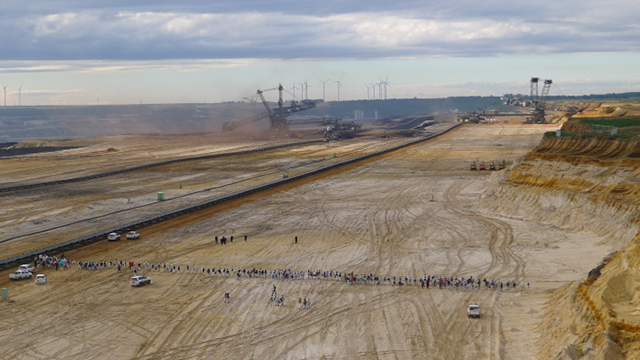
Did you know that Truthout is a nonprofit and independently funded by readers like you? If you value what we do, please support our work with a donation.
The raucous rattle of a low flying helicopter shakes me awake. It must be the Police. The sun hasn’t risen yet and the tent’s sides still smell of morning dew. I doubt I was the only one in this field who didn’t sleep deeply last night. Today is the day of action we have been waiting for Ende Gelände (Here and no Further) – 1500 people have pledged to enter RWE’s Garzweiler open cast coal mine, and block the gargantuan “bagger” excavators with their bodies, thus shutting down Europe’s largest source of CO2 emissions.
This is direct action as it should be. It’s not just a symbolic gesture that tells a story and makes an injustice visible, but an action which targets the very source of the problem and stops it in its tracks. Of course if the day is a success then its stories will work their magic, building confidence in the movements, being told around camp fires and cafés, buzzed through the social media sphere and printed as newspaper headlines. But the actual stopping of CO2 emissions themselves, the fact that the lignite coal, the dirtiest type of coal in the world, will not be dug out and burnt, is what counts. Ende Gelände is not a media stunt, it’s a collective act of resistance that for once feels proportionate to the scale of the emergency, catastrophic climate change, which is the size of the land, sea and sky combined. If all goes to plan, it will be one of the biggest acts of disobedience for climate justice ever. For many of those just waking up in this lush field, it will be the first time they have broken the law for their beliefs. The first time I took direct action was 20 years ago, but the nerves never go away and the butterflies are playing havoc with my intestines.
Thousands have been preparing for this moment over the last week at the Klima Camp. Inspired by UK Climate Camps which were born in the shadow of the Drax coal fired power station in 2006, this temporary model of an alternative society is set up a few kilometers from the open cast mine in a supportive farmer’s field. The complex operation is self managed via daily direct democracy meetings where issues such as how not to overburden the field’s WiFi, to organising the emptying of compost toilets are discussed. The organisation is impressive, there are solar panel points to charge up mobile phones, an onsite cinema, an ’emotional first aid’ tent for those going through tough times, rows and rows of identical white workshop tents and an entire circus marquee filled with toys for children.
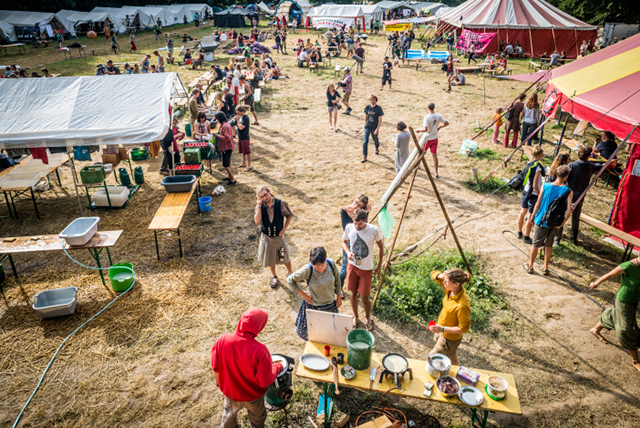 (Photo: Paul Wagner / 350.org)
(Photo: Paul Wagner / 350.org)
People from 45 different countries have been running and attending courses and workshops in everything from Transition Theater to Islamic Degrowth Economics, Urban Food production to the hands on building of a DIY wind turbine that now provides some of the electricity for the camp. What makes protests camps such powerful forms of social change architecture is that unlike a meeting hall, a squatted social center or an NGO’s offices, the borders of the space are porous. Anyone can walk in, there are no closed doors to knock on, or bells to ring, and no intimidating meetings to walk into. This makes it a lot easier for those new to activism to participate. One of the genius strategies for this particular camp, was the decision to merge the Climate Camp process, a radical activist grass roots anti capitalist movement, with the Degrowth Summer school, a more NGO, academic style talk shop, which nevertheless managed to bring 3000 people to its gathering in Leipzig last year.
As the 40 page thick program of the camp states: ” If we want to put into practice effective and equitable strategies against climate change, we need a fundamental transformation of our economy and of our way of life. (An) “energy transition” that is based only on renewables and efficiency but perpetuates the growth paradigm will not succeed in preventing run-away climate change, won’t do anything about the many social injustices we face and it won’t democratize society either. At this joined event we would like to connect debates around climate justice and degrowth and carry them to the place of a key energy struggle.”
In the past there has been a big separation between the NGOs and the grassroots movements acting on climate in Germany (as in many parts of the world). A lot of work has been done over the last year to bridge this gap for the Ende Gelände action. 350.org, the global climate movement spanning 188 countries, directly called for participation and brought a number of internationals including from Jordan and Afghanistan. German Friends of the Earth signed a solidarity letter and have been helping organise a legal march for families on the same day as the mine shut down. If we are to build a resilient movement of disobedience for climate justice, these kind of alliances are key, not so we can create so called “inclusive” and lowest common denominator type actions, but to legitimise creative and radical forms of mass disobedience and build a shared culture of resistance.
 (Photo: Paul Wagner / 350.org)
(Photo: Paul Wagner / 350.org)
In ecosystems it is at the edge, between a forest and a meadow for example, where there is the highest biodiversity and most number of relationships between different species. As a result it is there that evolution is the most powerful, where change and innovation are boosted. It is only by breaking out of our predetermined activist identities and ideologies and creating spaces that invite diversity and social experimentation that we will build a movement that is resilient and powerful enough to turn the juggernaut of business as usual around. The fertile edge created by the Klima Camp and the Degrowth Summer school, is already growing fruits.
In the main circus tent which holds several hundred people, we heard from speakers fighting against coal mines and nuclear power in India, oil extraction in the Amazon, first nations communities resisting the toxic disaster of the Alberta tar sands and eco-anarchists living in tree-houses to stop the expansion of the Hambach lignite mines nearby. We watched plays created and performed by refugees and asylum seekers. We took part in debates around new forms of radical democracy between people from the anti austerity M15 Spanish movements, Greek Anarchists describing the self managed health, food and production systems that have risen from the economic collapse and a Kurdish representative explaining the experiments in libertarian municipalism which is building a nation without a state, founded on feminism, ecology and radical autonomy in northern Syria. All the talks are simultaneously translated by volunteer translators, into at least 3 languages, via micro pirate FM radio transmitters. Like some kind of ticking human clock, at the center of the camp, sits a huge round trampoline on which gaggles of excited children bounce all day long, a salutary reminder of the future which sometimes feels so fragile.
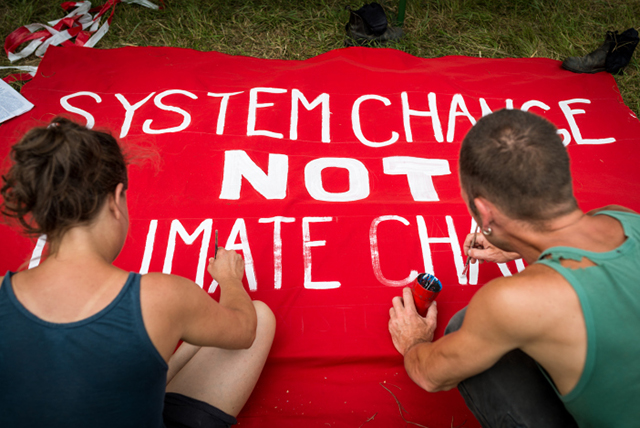 (Photo: Paul Wagner / 350.org)
(Photo: Paul Wagner / 350.org)
The Art of Affinity
The last few days here have been focused on disobedience trainings. The first thing we learn is the “Action Consensus,” which defines the tone of the action which all participants agree to stick to. It cleverly avoids opening up the can of worms of “violence and non-violence” by never using these loaded moralising terms. It states that “We will be calm and considered. Escalation will not be provoked by us. We will not put people in danger.” It also says there will be no damage of the machinery. This is not for moral reasons, more to enable the safety of all participants. As soon as things start to be broken, the police inevitably increase their violence towards us and charges for occupying a mine are much lighter than for property damage. If people want to sabotage things there are two other open cast mines in the area to play in anyway.
When I first got involved in direct action I thought that we could bring down the fossil fuel industry, and industrial civilisation to boot, just using openly announced acts of civil disobedience, by making the system unworkable. But through the years I realised that however big the movements are, we never have enough bodies willing to risk being arrested and ready to face the long drawn out court cases. Ask yourself – do we have enough bodies to shut down every open pit coal mine in the world, every oil refinery, fracking site and arctic rig, to bring the Mordorian tar sands in Alberta to a halt, to block all the chimneys of all the power stations in China? Of course we don’t, not even for one day, which we know would not be enough anyway.
The tactical success of the 90s anti roads movements in the UK, which managed to force the government to cancel 700 road schemes, was that whilst there were the people living in tree houses and tunnels on the sites blocking the destruction and many big days of openly called disobedience where we would digger dive together, there were also forays at night by what were know as pixies, who armed with sugar and wrenches put the earth wrecking machines gently to sleep. Our movements are going to need these big open days of disobedience, the long months of Blokadia and site occupations and the night time secrets if we are to be efficient.
The slogan ‘Keep It in the Ground!’ slips off the tongue easily. But actually stopping burning the 80% of the world’s fossil fuels reserves which we need to do if we are to avoid the catastrophe of runaway climate change is going to require every tactic we think is just, strategic and most importantly effective. Historically when resistors win it is because they fought harder than they thought was possible and used a whole pallet of possible tactics. One tactic the German movements have developed is known as “the finger.”
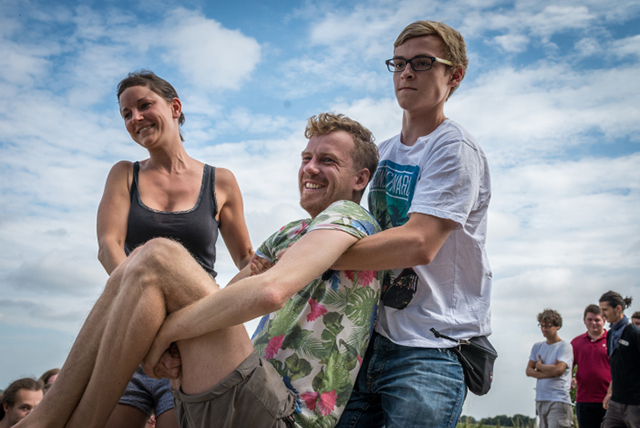 (Photo: Paul Wagner / 350.org)
(Photo: Paul Wagner / 350.org)
The most fun part of the training are the role playing exercises in fingers, long thin columns of bodies that flow through police lines. We have nothing but a bag of straw to protect ourselves and we try to imagine the line of sandal wearing friends in T shirts facing us as police clad in body armour with big sticks in hand. “That was easy” says Frida after we try the technique that involves a dance like side step before pushing through shoulders first, “But we all know it won’t be like that on the day!” Nervous laughter all around.
How to build an affinity group, an organisational approach which is at the heart of effective direct action is one of the most important parts of the training. An affinity group is a cluster of between 5 and 15 people who decide to work together – staying together during the action, looking out for each other, and building trust and emotional support to enable and empower its participants. Remaining autonomous, not relying on a top down command structure, but making their own decisions about what to do (and not to do), affinity groups are way more fluid and responsive than a larger mass of people. They are also fertile seed beds enabling new people to participate.
Decentralised and non-hierarchical, by their nature, the affinity group form was first invented by Spanish anarchists in the late 19th century, when circles of friends meeting in cafés, often at first to share cultural and artistic ideas (like a literary salon), began to talk politics and plan actions together. Decades later the form was resurrected during the anti-Vietnam war protests, by the infamous American post dadaist art activist collective: Black Mask. Some of the most successful mass acts of disobedience, from the huge, sometimes 30,000 strong, anti nuclear blockades of the 70’s to the turn of the 20th century shutting down of the WTO in Seattle, used affinity groups as the main fabric of the action.
What brings a group together is often sharing the same desires for the tone and style of action. Our affinity group for the day came together around the fact that none of us really wanted to be arrested, even though we were all committed to going into the mine and knew that the chances of getting away with it were very low. As it happened, as the day of action got closer and the excitement rose, our group collectively drifted into realising that not getting arrested for an act of mass disobedience was a bit like fighting a war for peace, by the eve of the action we no longer cared for anything other than getting onto one of the excavators.
 (Photo: Paul Wagner / 350.org)
(Photo: Paul Wagner / 350.org)
Sometimes affinity groups stay together for years, others are put together for a particular action. Some of us in our affinity group are already good friends, but others have never met before and for a handful this is their first act of disobedience. We are a sundry bunch, ranging from 21 to 50 years old and we include a Turkish designer, French journalist (there to act not report), Czech student, Danish NGO Campaigner, Spanish Environmentalist, Belgian Engineer and a British researcher. In the tradition of non-cooperation with the authorities, we have decided that we will refuse to give any names if arrested. Not because we are not proud to be shutting down Europe’s biggest carbon bomb, but because in the tradition of Civil Disobedience theorised and practiced by Thoreau, the Militant Suffragettes, Martin Luther King, Ghandi et al. we believe that noncooperation with what is wrong is as much a moral obligation as is cooperation with what is good.
If on top of that, if we can also avoid feeding this society of hyper surveillance that controls, checks, measures, films, files, tracks and captures our every move, then it is a win win situation. To facilitate our anonymity the legal team has invented an ingenious system, we give our ID documents to them and they give us each a number. If arrested we use our phone call from the police station to tell them our number and they are thus able to see who has been detained and send the appropriate support, without any name ever having been uttered.
A catchy affinity group name however is always motivating, we have decide to call ourselves: Mary Poppins, partly because we want to use some of the multicoloured umbrellas that have had images and texts stenciled on them, useful for shade, strong visuals and protecting us from pepper spray. It’s a nod to the Hong Kong democracy movements that turned the use of umbrellas into a fine art of resistance.
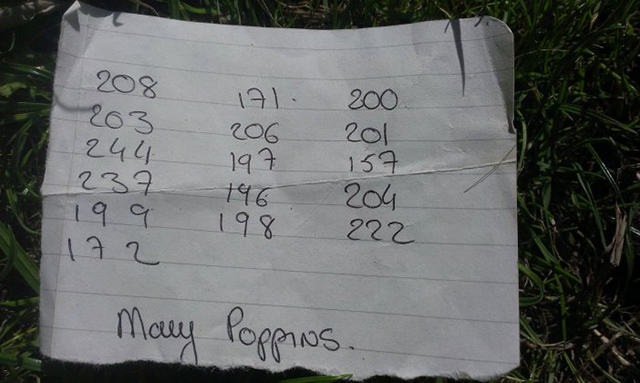 (Photo: Julie Andrews courtesy of P.L Travers)
(Photo: Julie Andrews courtesy of P.L Travers)
We have all paired up into ‘buddies’, two people who even in chaotic moments where the larger affinity group might get split up, stay together come hell or high water. Isa and I pair up as always, the last time we buddied up on an action I ran through a line of riot police without any warning and left her isolated on the other side, which is exactly what NOT to do with your buddy. This time I’ll try to be more aware and sensible.
Mary Poppins will be joining the “international finger,” one of the four columns made up of numerous affinity groups, that will walk into the mine from different directions and head for the diggers. After the fingers reach the machine, each affinity groups can decide what to do and where to go, ours still hasn’t decided, although I liked the idea that we would write a giant message in the sand a lot more than climbing to the top of the excavator, the world’s biggest land based vehicle, with our banner which says: Jobs not Coal.
Philosopher Frederic Jameson wrote that the “The central problem of all political philosophy (and later of political science) is the constitution of the group.” How do we treat each other? How do we make decisions in ways that reflect our desired world without hierarchy and domination? How do we listen deeply, debate, disagree, decide together? And how can we live now together as if we were already free? The affinity group form is a beautiful rehearsal for many of these questions. In German and in English the words ‘friend’ and ‘free’ both come from the same Indo-European root, which conveys the idea of a “shared power that grows,” a far cry from the atomised individualistic freedom of neoliberalism, which so often pollutes even the most radical of minds “I’m an anarchist! I’ll do what I want!” As the Invisible Committee explain in To Our Friends: “Being free and having ties was one and the same thing. I am free because I have ties, because I am linked to a greater reality than me.” If anything else an affinity group is an amazing accelerator of friendship, and when it is fueled by taking the risk of disobedience together, it becomes a love machine like no other, an ecology of freedom.
 (Photo: Paul Wagner / 350.org)
(Photo: Paul Wagner / 350.org)
Ghost Villages
Yesterday evening we visited Immerath, one of several villages that sits on the edge of the mine quietly waiting to be engulfed by the ever expanding hole. The long streets were deserted, windows and doors boarded up, shutters closed. A sizeable church with twin bell towers stood tightly padlocked, whilst around the corner the school still had kids drawings, their colours faded by years of sunlight, stuck to the dusty windows. Ivy grew through broken letter boxes and the once manicured gardens had turned to jungle. At the entrance of the village was a huge hospital complex, complete with its own chapel and a car park with grass growing high through the cracks in the tarmac. In the walled cemetery there were only a couple of headstones left, next to them were dozens of rectangular patches of disturbed ground where the bodies of the dead have been moved away to safety. Strange ghosts of graves in a ghost village waiting in silence for its day of reckoning. 35000 people have already been displaced in the area, 7000 (including the farmer whose fields we are camping in) await a similar fate.
A couple of evenings ago, Heather Milton-Lightning, a fist nations activist with a wicked sense of humour, gave a talk where she mentioned the 1990 Oka resistance, a 78 day blockade and violent standoff between first nations activists and the Canadian state who wanted to build a golf course on the site of the Mohawk’s ancestral graves. The plans were shelved and today the graves remain. But it seems that most people in this capitalist culture revere neither the living nor the dead enough to resist. As we leave the village I see a piece of paper cello-taped to one of the rare un-shuttered windows, it says: “people still live in this house.” It seems not everyone has given up in Immerath.
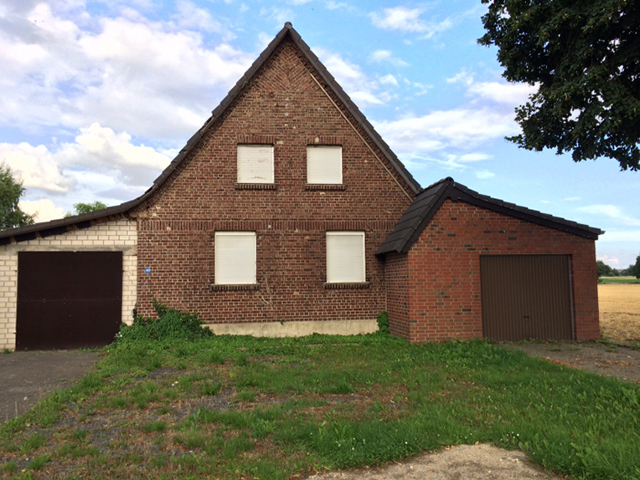 (Photo: JJ courtesy of J.L)
(Photo: JJ courtesy of J.L)
Afterwards we wanted to check out the mine from the special tourist viewing platform, to get us in the mood for the following days action. The mine and its accompanying power stations that seem to belch out fluffy ready made clouds, is surrounded by fields of industrial wind turbines. It is a kind of scenography of greenwash, an ‘eco’ back drop to make us forget that the “great green” German state which is phasing out nuclear power, and is renowned for its “renewable energy transition,” now produces 45% of its electricity with coal.
The lanes leading to the mine are already blocked by police and so we turn back to camp, I’m already shaken enough by the ghost village there is no need to see more devastation. Apparently 1500 officers have been mobilised for the action, that’s one for each activist, not counting their horses, dogs and the 800 RWE workers and security that are rumoured to also be protecting the mine.
 (Photo: JJ courtesy of J.L)
(Photo: JJ courtesy of J.L)
Running for Life
“Gooooood morning everyone… time to wake up!” a voice pipes through a megaphone, “we leave in 45 minutes… Ende Gelände!” A semi comatose cheer rises from the tents. The start time of the action has been kept secret up till now to take the authorities by surprise. Bleary eyed but energised by the rising adrenaline our affinity group meets up, distributes sandwiches and water, and writes down the phone number of the legal support team with indelible ink on our legs. We put on the white paper boiler suits which everyone on the action will wear and adjust the dust masks that will protect us from the coal particles. As we will be near the front of the finger, and therefore some of the first to flow through police lines, we also wear eye protection, made of overhead projector film, that we hope will shield us from their pepper spray. “WHERE ARE THE UMBRELLAS?” I shout above the drums of the samba band. “Someone took them already” replies Martin. “Not enough umbrellas for Mary Poppins! ” he laughs. The four fingers are lining up, 1500 people all in white, waiting, excited eyes peeping above dust masks, all ready to disobey. The megaphone screeches “Ende Gelände” and we’re off.
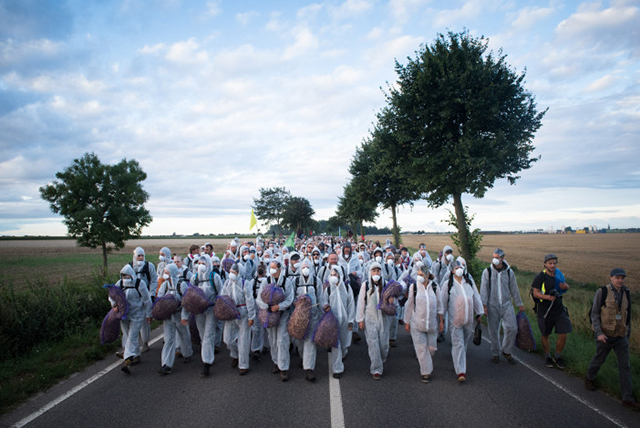 (Photo: Ruben Neugebauer courtesy 350.org)
(Photo: Ruben Neugebauer courtesy 350.org)
Our 280 person strong finger is first to leave, we move fast through the country lanes, we sing songs to calm the collective tension, flags with painted slogans: CLIMATE INTIFADA, GLOBAL BLOCKADIA, STOP CO2LONIALISM flutter in the dawn light. To get to the mine we have to cross under a motorway via a narrow concrete tunnel. It’s blocked by two vans and three rows of riot police. We know what we have to do. Many of us have trained for this moment. No one runs, we take a deep collective breath. “KEEP TOGETHER! KEEP TIGHT!” I think of my friends in the first line, made up mostly of an all women affinity group, last night they told Isa that they wanted to “Challenge themselves.” Right now that sounds like an under statement.
Here goes! I put my head down. Body, mind – thought, action – time and space – all fuses in that micro-moment. Nothing matters anymore, it’s like meditation – but on steroids. The finger flows like a restless river straight into the police line, the whole column driving from behind – 280 bodies pushing and pushing. We feel the hulks of armour, the hardened helmets, the black padded punching gloves against our soft bodies. Weapons designed to hurt us are flailing against our flimsy bags of straw. In the corner of my eye I see a truncheon heading for my legs, it hits me hard but the adrenaline cuts out the pain. A jet of pepper spray heads directly at my eyes but is stopped by the makeshift visor. Some people fall, a pile of bodies, screams, I trip. Isa pulls me up out of the scrum, and we run. Faster than I thought possible.
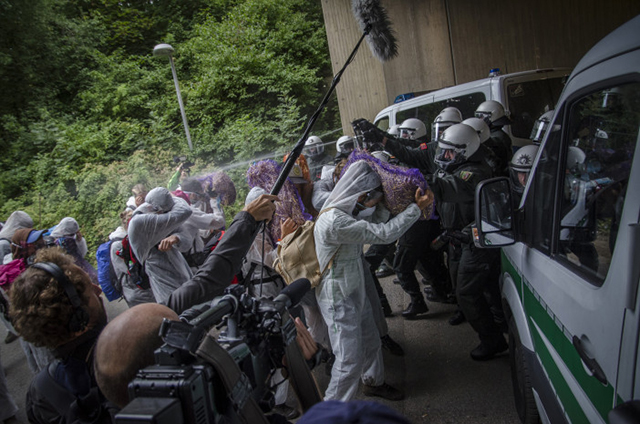
And then we are through – so much joy in everyone’s eyes. We race into the field ahead but soon realise that one of our affinity group is missing. “MARY POPPINS! MARY POPPINS! REGROUP.” Behind us a dozen activist are being wrestled to the ground and arrested. There is nothing we can do to help them now, most of us are through and we have to keep going. Two hares race across the stubbles of wheat beside us, my favourite animal, an ancient trickster symbol, the shape-shifter who provokes authority and bends laws with its wit and wisdom – surely it is a good omen.
Then on the horizon another line of police is forming, dark shapes swinging batons, faces hidden behind balaclavas. I see Tara next to me, she in the Acornaffinity group, she’s tiny and has never done anything like this before. “My heart is beating so fast it feels like its going to explode!” her eyes are enormous. ” It’s normal to be scared” I respond as I see a friend dodge another truncheon swing. “Courage come from the french word for heart – le coeur.” I hold her hand and we run together.
Our finger hesitates and then spreads out across the field, there are ten times more of us than them, but it’s still terrifying. We go for the gaps in the polices line. Through again. More police vans are heading our way, one has huge loudspeakers mounted on the top: A voice of authority warns us of something, my rubbish school level German just makes out that he’s telling us not to do something. The pepper spray is beginning to hurt, people are turning bright red and wincing. Samantha is jumping up and down in pain as she runs. Picture someone stripping off your skin and plunging you into a bath of Tabasco sauce or the worse sun burn you could ever imagine.
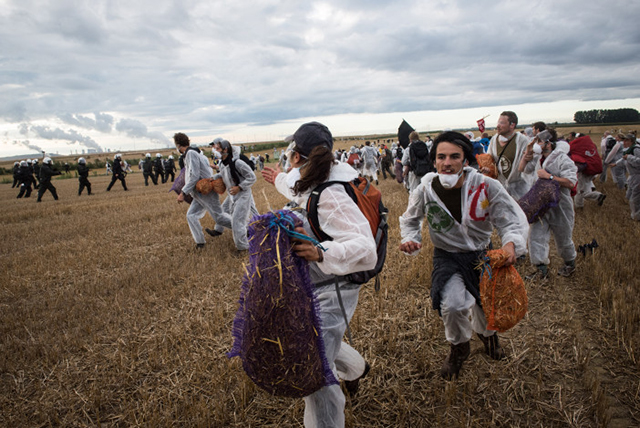 (Photo: Ruben Neugebauer courtesy of 350.org)
(Photo: Ruben Neugebauer courtesy of 350.org)
“MIND THE DITCH!” We scramble up a steep bank of crumbling earth, hands held out helping each other over and then down into a wet marshy zone. Water is spraying from dozens of tall lamp post like structures, “It’s to keep the tonnes of coal dust down” Mary tells us. The shower of water soothes our stinging skin for a brief moment, but we have to keep going. And then we are there, over the edge, pouring down into the mine’s chasm, breathless from the running and from the awe of what we see stretching in front of us. 12 kilometers wide, 400 meters deep, the biggest hole I have ever seen. A hole that has eaten up so many peoples homes and lives, a hole that makes money for a few and imposes misery for most, a hole that belongs better on Mars than on this planet and yet could be leading us into similar lifeless landscapes.
Half a dozen excavators are still working, 222 meters long and higher than the statue of liberty, they gnaw at the sides of the canyons, mighty steel insects eating the earth away 24/7. Clouds of black dust fill the sky around them. Each one uses the same electricity of a small town and can dig 2400 train carriages of coal out per day. Iconic in their monstrosity they even appeared in the background of the Hunger Games films, in the apocalyptic grey wastes of district 12. These are machines that are engineered to cut through mountains, designed to spread deserts far and wide. The sun is beating down, the deep pockmarked sand is hard to walk through. JG Ballard described deserts as “timeless wastes” landscapes that have “exhausted their own futures, and are thus free of time.” This place is in the process of exhausting our collective future, one tonne of coal at a time.
White RWE 4×4 pick up trucks full of workers dressed in orange florescent overalls are heading our way. But they don’t to stop us. The workers get out, stare bemusedly and take pictures with their smart phones. The nearest digger is about 2 kilometers away, it feels nearly in reach. The mood relaxes and at at last we slow down to walking pace. Perhaps the police won’t even come into the mine, it is after all private corporate property. People start to chat, a few songs are sung, “Bagger Ciao, Bagger Ciao, Bagger Ciao Ciao Ciao.” We made it, we made it into the bloody mine. Mike turns to me, sweat pouring from his forehead: “It is hard to imagine the ten destroyed villages that were once in this void. I’m trying to work out where the bakery, pubs and farms would be hanging in this nothingness?”
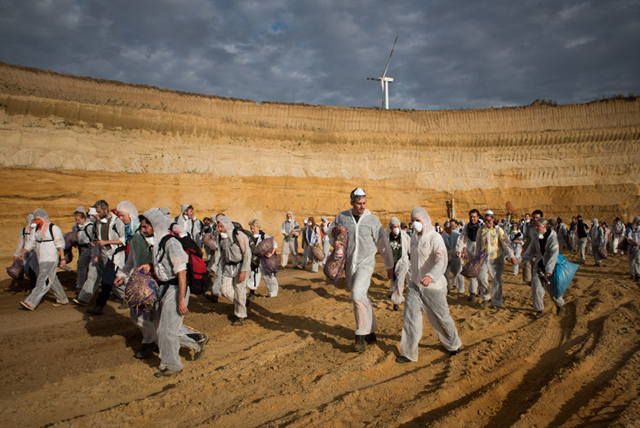 (Photo: Ruben Neugebauer courtesy of 350.org)
(Photo: Ruben Neugebauer courtesy of 350.org)
The calm lasts a little moment, when out of a cloud of sandy dust come more RWE pickup trucks, this time over a dozen of them. They are coming from behind us, chasing us. Hanging out of the back are the ominous dark green shapes of riot police, my mind flashes to images of ISIS racing through the desert. We run again. The sand is sucking all my life’s energy down into it. I just can’t keep this up anymore. I want to give up. But then someone grabs my right hand, someone else reaches for the other one. We are making a human chain 200 bodies long that stretches from one of the whirring 16km long conveyor belts to the cliff edge of the mine, a barricade of flesh to stop the pick up trucks. Like the magic of collective intelligence that ants display, our bodies choreograph themselves without words, through sheer rebel intuition and a sense of deep attention.
More trucks appear ahead. Police jump out. I’m loosing count of how many lines we have flowed through today – 3, 4? My mind is fixed on getting to the machine but it feels as if my body won’t make it. I’ve never wanted to be arrested before, but part of me is just praying for that moment now, just to be given the chance to stop running, to lie down, to feel my legs again. More pepper spray, truncheons, arrests. Bodies falling in the sand around us. Somehow we slip through once again. Everything is a blur. Dozens of dark shapes are surrounding us. “THEY ARE TRYING TO KETTLE US. KEEP TOGETHER! BREAK OUT! BREAK OUT!” A last cry of hope, but we know that we haven’t got the energy to make it to the machine. It’s only 800 meters away, but might as well be on the other side of the world.
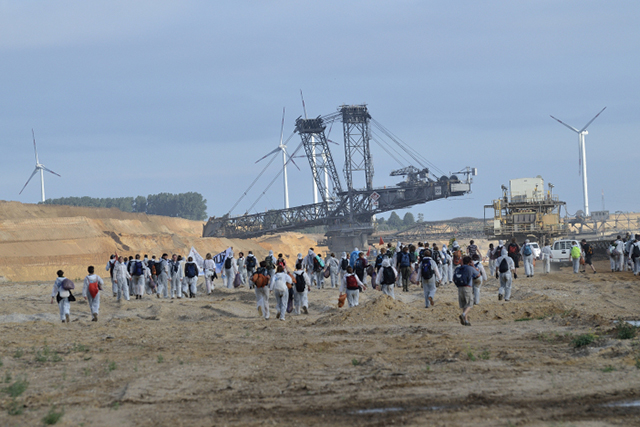 (Photo: Tim Wagner courtesy of 350.org)
(Photo: Tim Wagner courtesy of 350.org)
Then we fall, first my buddy then me, the shadow of a riot cop looms over us. We could probably make another run for it, he can’t grab both of us. Isa looks up at me: “Is it over?” I ask, “Yes” she whispers. I’m so deeply relieved. My whole body melts into the sand, we huddle together and wait for the pain of a truncheon blow that miraculously never comes. Ahead the last of our finger, a hand-full of 30 people manages to make it a few more hundred meters towards the excavator but they too are soon surrounded.
The running is over, now comes the interminable waiting. The police cable tie our hands tight behind our back, there must 100 of us kneeling in the sand deep in this hole here encircled by men and women paid to stop us protecting life. Some of us are screaming in pain from the pepper spray, others are nursing hurt limbs. Malvin can’t feel anything in his right hand. An ambulance arrives, the same cops who an hour ago were beating him, take him to the medics. They ask for his ID, he refuses. “No ID – no medic” they reply. Indignant the medics take Malvin out of the hands of the police, “he’s coming with us” he glares at the officers “you can do what you want!”
The riot police take off their helmets. I chat with a young officer. “This is not the way to protest” he tells me. “Everything you take for granted” I respond “the right for women to wear trousers, to vote, the right to contraception, the right to take a weekend, to join a union, even the eight hour day. All those things you have because people disobeyed the laws of their time.” He nods. “Maybe you’re right, but those were human rights they wanted.” I point to the excavator, “Burning that coal today is affecting humans… Droughts, harvests collapsing, homes flooding – 100 million lives are expected to be lost over the next 18 years due to climate change, most of those in countries which produce very little CO2. Don’t those people have rights?” He looks away, we stop talking.
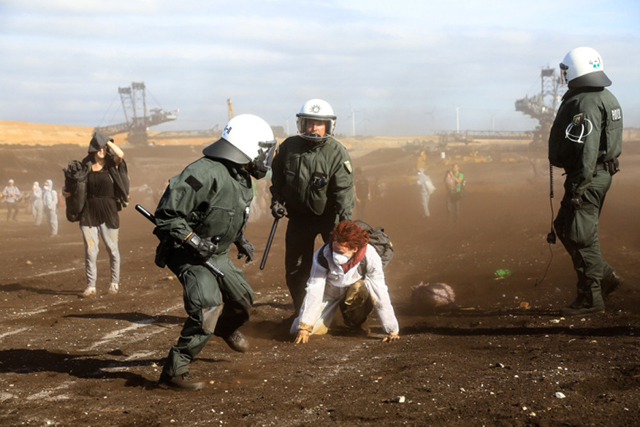
We remain there for nine hours in the baking sun finding ways to make shadow for each other and deeply nourished by acts of tender solidarity. Unable to feed ourselves people pass food from mouth to mouth, kissing relative strangers in the process. Some contort their bodies to help each other drink and wash the pepper spray from each others eyes. Laura manages to massage our burning hands with a such softness. An improvised game of volley ball is played and some even manage to throw a Frisbee with hands tied behind their backs. The sense of collective joy hasn’t faded it has just become tinged with absurdity. The power of common love that mass disobedience engenders can’t be taken away by their weapons or their prisons, it’s more powerful than anything they can muster against us. Then news comes in of the other fingers. Every one of them got into the mine and Yellow finger has climbed an excavator, everything has shut down, thousands of tonnes of CO2 won’t be released today.
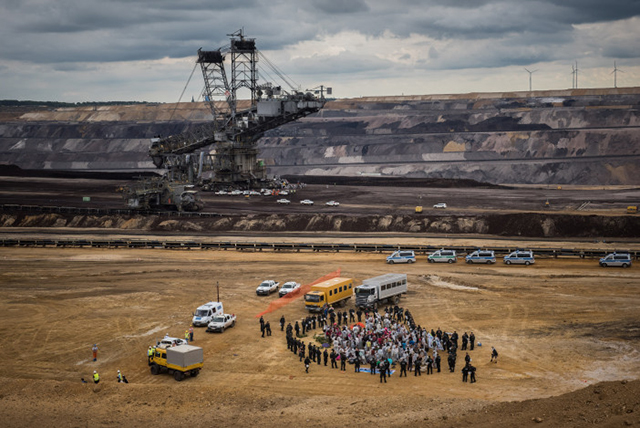 (Photo: Ruben Neugebauer courtesy of 350.org)
(Photo: Ruben Neugebauer courtesy of 350.org)
Journey to Jail
It’s 10pm. Hundreds of us are crowded onto several municipal buses that have been requisitioned to take us to the jails where special cages have been built to put us in. A police convoy with blue flashing lights follows us to Aachen 30 kilometers away. 800 people have been arrested. The trouble is that so many of us have decided to remain anonymous that the state bureaucracy has broken down, they have never had to deal with so many refusing to cooperate. When we arrive at the police station there is already a solidarity demonstration outside.
The hours of waiting in the bus have been filled with political discussions, absurd games, jokes and sharing stories of the action. “I’ve never had a day like that” says Joe who can’t be much over 16 “it felt like a real world video game, being chased by cops and going from one level to another.” One by one they start to take us off the bus and try again to get our names and finger prints using more threats of serious repercussions if we refuse. It’s going to be a long night.
The adrenaline is fading and boredom is setting in. It’s raining outside and we have eaten all the food we brought with us. People are sleeping rolled up fetus like. Whilst time stood still this morning, now it feels like an interminable burden. Every now and then we see someone leaving the jail and walk towards the solidarity demo after being processed, we wave and cheer them on.
Then without warning a couple of officers get on the bus, the engine starts up and the doors close. It slowly pulls out of the compound. Where are we going? “THEY ARE TAKING US TO THE TRAIN STATION!” someone shouts “WE ARE FREE!” Screams of laughter, applause, disbelief. The bus erupts into song: “Power to the people, the people have the power” the party begins and lasts well into the night, long after we get back to the camp which is buzzing with the irresistible exhilaration of success. History rarely offers us days like this.
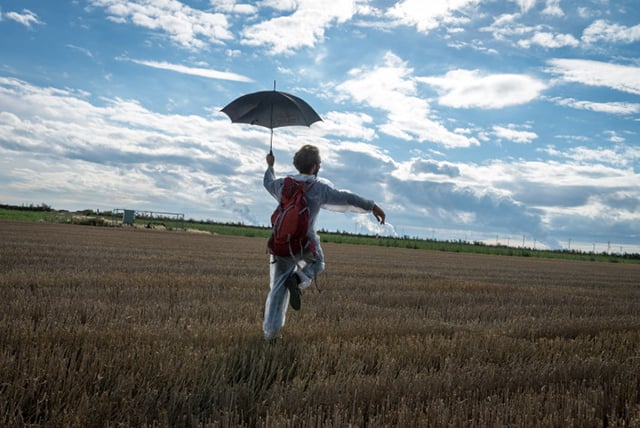 (Photo: Tim Wagner courtesy of 350.org)
(Photo: Tim Wagner courtesy of 350.org)
This Changes Everything
In that brief day everything changed for the European climate justice movement. Thousands experienced a collective power rarely felt within the competitive obedient individualism of capitalism. I have never seen so many people jump so far out of their comfort zones and take direct action for the first time. Never have I been part of such disciplined determined disobedience, whose tone seemed so perfectly balanced. It was neither the hard core, macho – ‘I’m more radical than thou’ approach, nor was it the paternalistic judgmental trap of polite pacifism. Ende Gelände merged direct action, which is about disruption and gaining direct results (stopping the mine) with civil disobedience which is often simply about performing an “illegal” act for the purpose of appealing to authority. In so doing it feels a new form of tactics and culture of action could re-emerged. As the civil rights movements knew so well, it’s not by convincing people, just shifting consciousness, that society changes, it is by forcing corporations to lose money. In their case it was the segregated bus companies, shops and restaurants. In ours it is the fossil fuel companies and the network of finance that supports them. Ende Gelände must have cost the state and RWE a lot that day.
It is time to move away from the purely symbolic and ritualized displays of dissent and reclaim tactics that are proportionate to the problems. Our tactics should be measured by their effectiveness, not their adherence to principles loaded with value judgments. Is this blockade going to work? Will mass arrests galvanise or weaken us? Is sabotage a better option at this moment in time? Will small affinity group actions or mass disobedience be best for this day of action? These are the types of questions that we should be asking. We need to create a culture which embraces a diversity of tactics whilst being able to agree to act together with clear action consensus when necessary. This means more listening, more attention and more letting go of our fixed positions.
But the more successful we become the more repression we will see, I lived through the rise and fall of the anti-globalisation movement and Occupy and neither of these movements were prepared enough for the inevitable repression that was to come. The liberal myth that “if we are non-violent then the state will not be violent towards us” must be buried once and for all, it is dangerous and strategically useless. When you start to win, they start to fight you harder than you ever imagined. First they divide and conquer, then co-opt and digest the movements. Only a broad space of disobedience where we do not condemn the actions of others will keep us strong. We must hold ourselves together in unity and diversity, just like the rich networks that make up the resilient ecosystems we are protecting. Perhaps the old words, Civil Disobedience and Non Violent Direct Action are no longer useful, perhaps we need new terms for a movement that puts winning ahead of moralising.
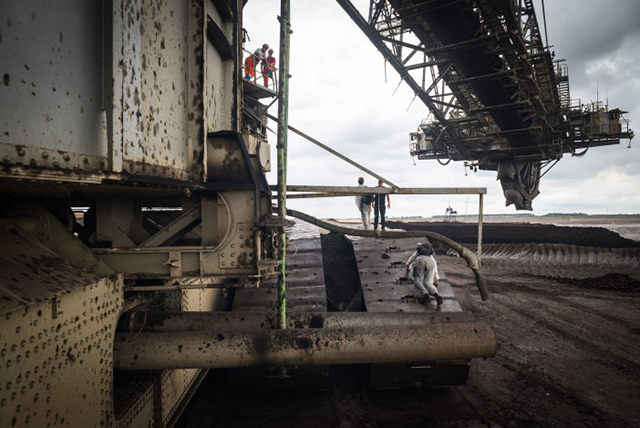 (Photo: Paul Wagner, Courtesy of 350.org)
(Photo: Paul Wagner, Courtesy of 350.org)
A spark was released from that monstrous hole that day, one that could light the powder keg of a cross border constellation of disobedience for Climate Justice that is rising faster than the global temperatures. But the raw material of courage is not these brief heroic moments, it is time – it is keeping going, blocking business as usual again and again, continuing to disobey despite the ups and downs that will inevitably accompany us on this adventure.
As I write the excavators have restarted and the coal is being burnt again. A quick check online of RWE’s share price however shows that since their disastrous loses announced at their last quarterly on the 13th of August and the direct action a few days later, their share price has been plummeting. A double whammy of investors pulling out of coal towards renewable and a successful movement against their mines is having its effect. The images of corporate vehicles filled with cops hunting activists down has ignited public debate around the boundaries between state and capital, and RWE has announced that they will prosecute all 800 people who went got into the mine, including some of the journalists that were stopped from doing their work and arrested. All this will only put the company’s destructive practices further in the public spotlight. How they are going to catch those of us who gave no names or addresses is a mystery.
As I leave the Camp for the long journey home, I see Tara beside the mobile bakery that produced over a tonne and a half of organic bread this week. “Are you OK?” I ask. Her heart shaped face breaks into a wide smile. “It was extraordinary. And you know what – I was so nervous I even forgot to take my passport out of my pocket before the action. But after I got caught I somehow managed to bury it in the sand, even with handcuffs on … It is still there in the mine!” I laugh out loud. “I’ll see you in Paris at the COP21 for the Climate Games!” I say. “Of course, adventure is addictive” she winks.
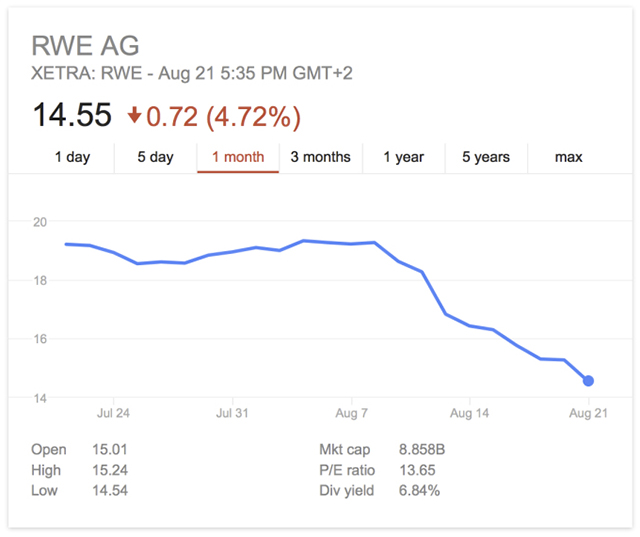
Next Step Paris – Redlines Are Not for Crossing
The contagious enthusiasm released from Ende Gelände will inevitably feed the mobilisations for the COP21 UN climate talks in Paris in December. In 20 years of UN talks, the emissions have risen by 63%. Whichever way you look at it, the COP process has been a total failure. We know that the corporate dominated talks – sponsored by energy companies, air lines, car manufacturers and banks – will never produce an agreement that deals with the underlying causes of the climate catastrophe and yet we cannot just ignore this moment where Paris becomes a stage to play out the struggle of life against business as usual.
Normally during these summits, every one plays their well rehearsed roles: delegates argue over draft text; big NGOs cheer them on to ‘seal the deal; grassroots activists try to unmask corporate lobbyists and take symbolic actions. But nothing matches the task of ending fossil fuel use and avoiding disaster.
An alliance of hundreds of NGOs and Grassroots groups from around the world have called for a day of action on December the 12th, named D12, to be held at the end of the summit (officially the talks end on the Friday 11th but historically, they have never finished on time and have always stretched into the next day). Thousands are estimated to come to Paris to take part and if we play things right it could well be the next biggest act of disobedience for climate justice. The problem is that there aren’t any big excavators, pipe lines or power stations to block in Paris, so what kind of tactics would be relevant especially as we don’t want to give legitimacy to the broken UN process?
The inevitable bad UN agreement will be a death sentence for the poor and the planet and a blessing for corporations, but world leaders will have no problem pretending that it is a success and the ‘best’ they could do. We cannot let such a deal pass unchallenged. The call for D12 is that “We (the movements) will have the last word,” but the actions which accompany “the last word” cannot simply become a footnote to the main story.
“PARIS AGREEMENT SIGNED – PLANET SAVED!” could well be the headlines on the last weekend of the talks, with a little paragraph – “activists were unhappy with the deal and had a protest – there were some arrests.” The rising climate justice movements deserve more than a footnote. It’s time for a bold move and for us to all step out of our comfort zones. We need a move that marks COP21 as the moment where the Climate Justice Movements could no longer be ignored. Discussions are taking place within the movements about what kind of action will take place on D12.
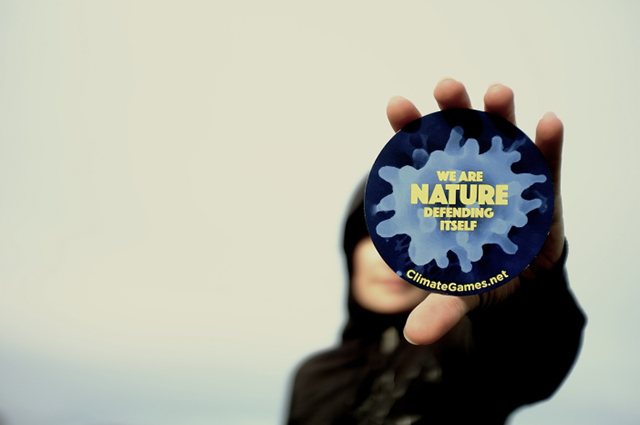 (Photo: JJ courtesy Climate Games)
(Photo: JJ courtesy Climate Games)
There are already some great tools for action, such as the Climate Games, which are being worked on. The Climate Games will enable people in teams (affinity groups) to take action in the streets and map them with a special anonymous application that shows targets, police and actions on a live map of resistance. Round 2 of the Climate Games will take place on D12 but the games are more a tool than an action plan. The action plan that is being discussed that touches me most at the moment is called REDLINES ARE NOT FOR CROSSING. It has been put together by a group of scientists and activists, NGO workers and grass roots groups and I think it’s the one which could catapult the movements onward and upwards with enough confidence for post-cop21 mobilising.
The idea is that five red lines, MINIMAL NECESSITIES FOR A LIVEABLE PLANET rooted in scientific evidence, equity and justice, are drawn up by the global social movements and brought to light via the choreography and visuals of the mass marches of the 28th/29th of November, the eve of the COP21 opening. Two weeks later, when the deal inevitably crosses these red lines, people encircle the summit and in a show of collective power and shaming, refuse to let the delegates return home to carry out the criminal agreement in their communities.
The red lines could include 1.) EMISSIONS: Drastic immediate cuts in CO2 emissions, ending fossil fuel use by 2050, 2.) EQUITY: Recognition of historical responsibility of rich countries and transfer of rights to emit from rich to poor countries on a per capita basis 3.) FINANCE: Rich countries pay poor countries for clean energy transition, adaptation, resilient agriculture etc immediately 4.) JUSTICE: Compensation to impacted communities for the loss and damages inflicted by past fossil fuel emissions and workers livelihoods secured through mechanisms for a Just Transition to a post fossil fuel world. 5.) COMPLIANCE: Force the elite to deliver on promises. Monitoring and penalties for non compliance.
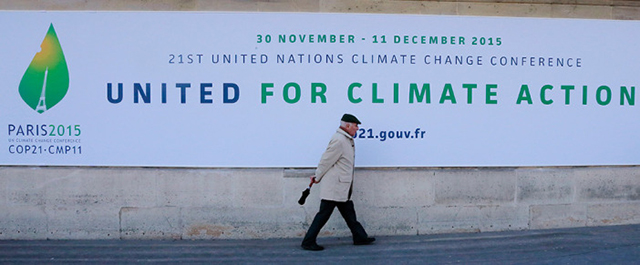
IMAGINE: When the summit inevitably crosses these red lines and just as the final UN plenary begins – the church bells, synagogues, minarets and civil defense sirens blast across Paris. This is the sign for the start of the action, people begin encircling the summit.
Three circles are made. On the inside of the Le Bourget conference center, hundreds of civil society NGOs, scientists and defecting delegates hold hands and refuse to let the delegations leave. Outside a middle ring of people surround the conference center, their backs turned towards it. Some have come with wind turbines, solar panels, bikes and mobile gardens, others are setting up tents “Occupy” style, hundreds of chairs re-appropriated from banks funding climate crimes form an alternative assembly as a barricade, farmers have driven tractors into place together with the frontline communities from la ZAD to the Pacific islands, everyone is calm and determined but refuses to be moved. If country representatives want to leave Le Bourget, then it will be by walking over the bodies of the very people they claim to represent.
Transport hubs and other roads that would enable delegates to leave Paris are also being blocked by smaller affinity groups; and finally an outer ring of tens of thousands, unable to come to Paris, take solidarity Blockadia actions in their own territories. The “red lines” meme appears everywhere, drawn across train tracks carrying coal, stretched across the entrances of institutions that refused to divest, marking the fields were fracking rigs are planned.
The mass act of legitimate disobedience fills the front pages and the airwaves, the social media sphere buzzes, washing away the world governments’ greenwash with images of creative resistance, no one believes that a bad deal is a good deal anymore, everyone sees it for what it is – the ultimate false solution. Plans for a mass shut down of ‘carbon bombs’ across the world in the spring of 2016 are announced as the blockades are lifted. Rather than a Copenhagen hangover, we return from Paris filled with confidence and a much clearer path emerges towards climate justice in the months and years ahead.
This may seem utopian to some, but now is not the time for realistic plans, but ones that make us dream of what is possible. Ende Gelände drew a line in the sand (Here and no further), in Paris that line turns red – the corporations and governments have failed us, it is time to take things into our own hands.
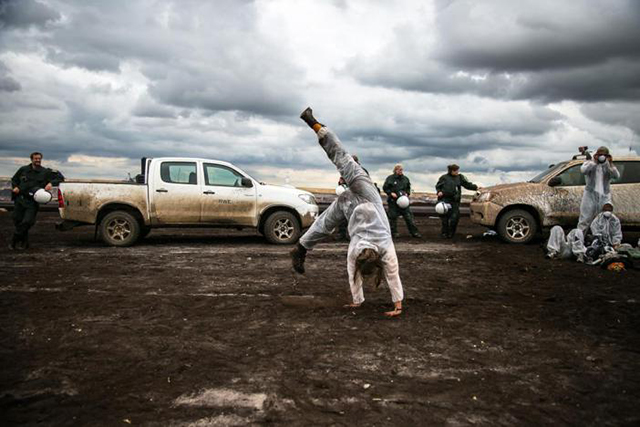
Press freedom is under attack
As Trump cracks down on political speech, independent media is increasingly necessary.
Truthout produces reporting you won’t see in the mainstream: journalism from the frontlines of global conflict, interviews with grassroots movement leaders, high-quality legal analysis and more.
Our work is possible thanks to reader support. Help Truthout catalyze change and social justice — make a tax-deductible monthly or one-time donation today.